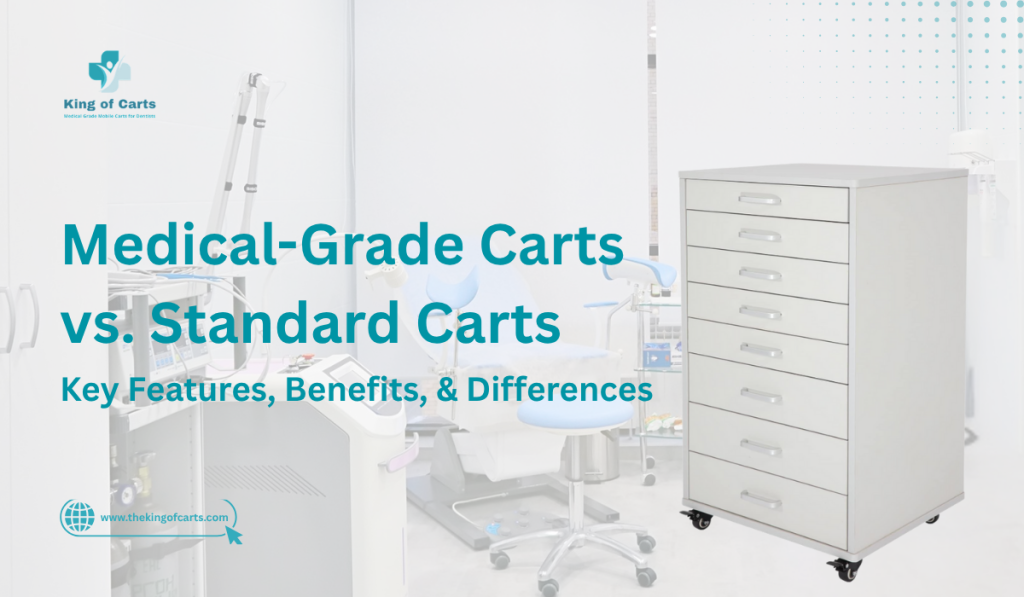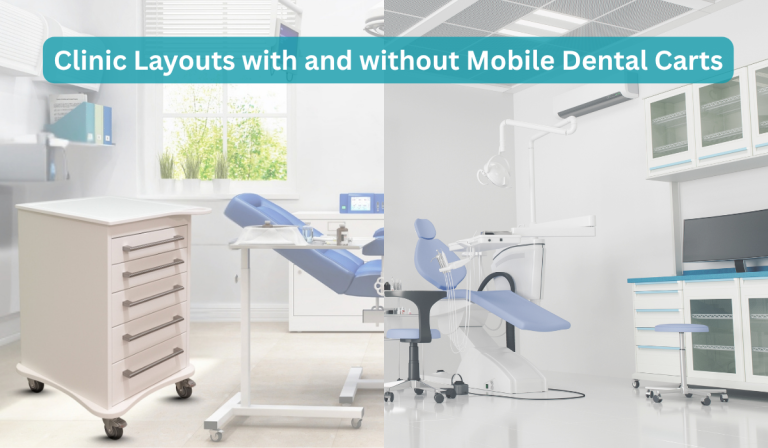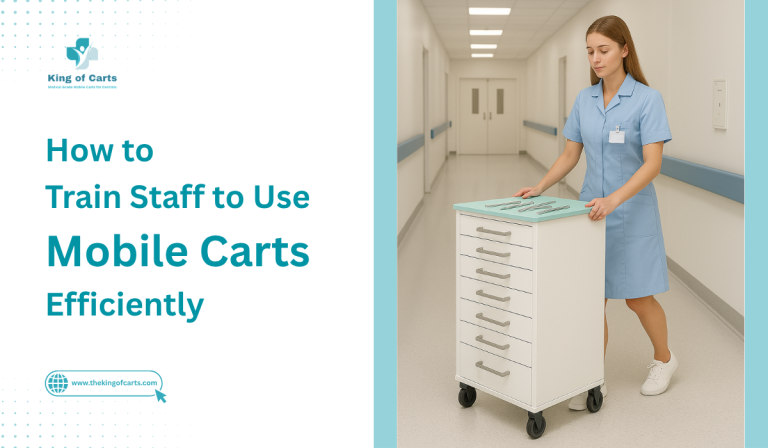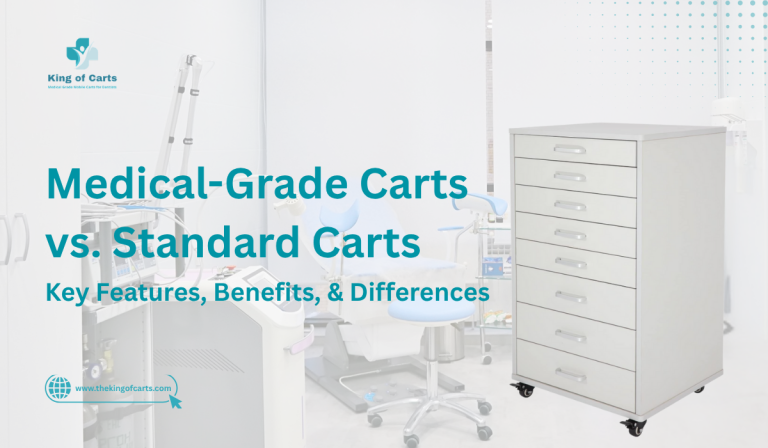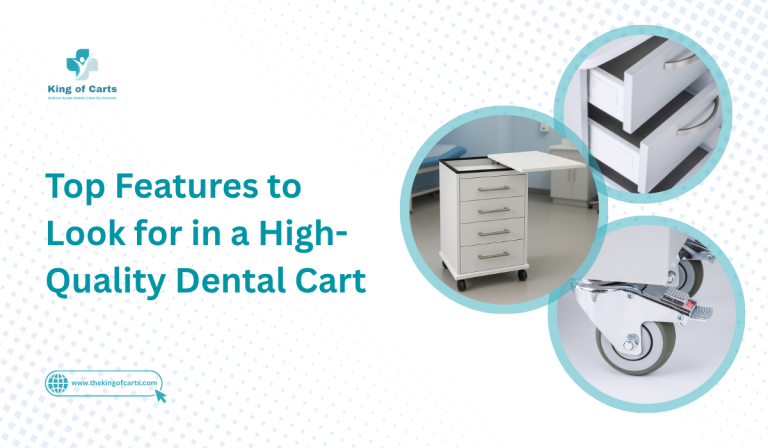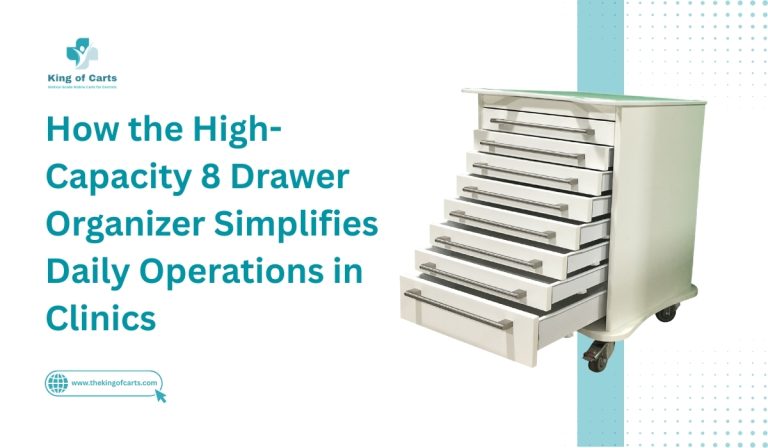In professional and healthcare environments, organization, hygiene, and durability aren’t optional—they’re essential. From hospitals and dental clinics to laboratories and care centers, carts play a vital role in ensuring smooth operations and efficiency. Yet, one common question arises when choosing storage or transport solutions: what’s the difference between a standard cart and a medical-grade cart?
At first glance, they might seem similar. Both have wheels, drawers, and storage space. But dig deeper, and the distinctions become clear—especially in terms of materials, hygiene, and compliance with healthcare standards.
Let’s explore what truly sets medical-grade carts apart from standard carts, and why investing in the right one can make all the difference.
What Is a Medical-Grade Cart?
A medical-grade cart is purpose-built for healthcare environments—designed with strict standards for hygiene, durability, and safety. These carts are engineered to meet the unique demands of hospitals, dental offices, laboratories, and surgical centers, where infection control and efficiency are top priorities.
Unlike standard carts, medical-grade models are constructed from materials that resist corrosion, withstand frequent cleaning with harsh disinfectants, and inhibit the growth of bacteria. Every component—from the casters to the handles—is selected to ensure smooth operation, easy cleaning, and long-lasting performance.
You’ll find medical-grade carts used in various settings:
- Hospitals and clinics: For transporting medical instruments, medications, and equipment.
- Dental practices: As mobile workstations and tool organizers.
- Laboratories: For securely storing and moving sensitive materials.
- Emergency rooms and operating theaters: Where sterility and reliability are critical.
In short, a medical-grade cart isn’t just a storage unit—it’s a carefully engineered piece of equipment designed to support healthcare professionals and safeguard patients.
What Is a Standard Cart?
A standard cart, on the other hand, is a general-purpose storage or utility unit. These carts are commonly used in offices, schools, warehouses, and workshops. While they serve everyday needs effectively, they are not designed to meet medical hygiene standards.
Standard carts may be made of metal, wood, or basic plastic. They work well for light-duty tasks such as storing tools, office supplies, or cleaning products. However, when it comes to environments that demand frequent sterilization or exposure to disinfectants, standard carts tend to fall short. They can:
- Develop rust or corrosion over time.
- Harbor bacteria in cracks or porous surfaces.
- Degrade when exposed to strong cleaning agents.
- Offer limited durability and load capacity.
That doesn’t mean standard carts are inferior—they simply serve a different purpose. But in healthcare, where hygiene and reliability are non-negotiable, medical-grade carts stand in a class of their own.
Key Features That Differentiate Medical-Grade Carts
So, what exactly makes a cart “medical-grade”? Here are the defining features that set them apart from standard designs:
1. Antimicrobial Surfaces for Infection Control
In medical environments, controlling infection is a top priority. Medical-grade carts often feature antimicrobial coatings or materials that actively inhibit the growth of bacteria, mold, and viruses on surfaces.
These coatings are especially important in hospitals and clinics, where carts come into contact with patients, equipment, and staff throughout the day. Antimicrobial technology helps maintain a cleaner surface between disinfections, adding an extra layer of protection that standard carts simply don’t offer.
2. Water-Resistant and Easy-to-Clean Design
Medical-grade carts are made with non-porous materials—such as powder-coated steel, stainless steel, or reinforced polymer—that can withstand exposure to cleaning chemicals, water, and disinfectants.
Their surfaces are smooth and seamless, preventing the buildup of dirt, dust, or microorganisms in hard-to-reach crevices. Many also feature removable drawers and smooth edges for quick sanitization.
Standard carts, in contrast, may absorb moisture, warp, or corrode when cleaned frequently. Over time, this not only reduces their lifespan but also poses hygiene risks in clinical settings.
3. Heavy-Duty, Corrosion-Resistant Construction
Medical carts are built to last. They are designed for continuous use in demanding environments where durability matters. Whether carrying heavy medical instruments, electronic equipment, or essential supplies, they’re engineered to handle significant weight without wobbling or wearing down.
Materials like stainless steel and medical-grade polymers ensure long-term reliability and resistance to rust or chemical corrosion. The structural integrity of a medical-grade cart far exceeds that of a standard one, making it a smarter long-term investment for professional environments.
4. Smooth Mobility and Ergonomic Design
Mobility is another critical differentiator. Medical-grade carts are equipped with high-quality casters that roll smoothly across various floor types—be it tile, vinyl, or carpet. Locking mechanisms ensure stability when parked, while precision bearings prevent noise and uneven movement.
Many models feature ergonomic handles, height-adjustable trays, and soft-close drawers to improve comfort and usability for healthcare workers. These details may seem minor, but they make a major difference during long shifts and high-pressure situations.
Standard carts typically lack these advanced features. Their wheels may not handle frequent movement or heavy loads as efficiently, leading to wear and difficulty maneuvering over time.
5. Certified Quality and Compliance
Medical-grade carts often comply with healthcare safety and quality standards, such as ISO certifications or FDA guidelines, depending on their use. This ensures they meet strict criteria for material safety, design, and hygiene.
Standard carts, while suitable for everyday use, don’t undergo the same rigorous testing. They’re not required to meet the sanitation, fire safety, or durability benchmarks necessary in medical environments.
Comparing Medical-Grade and Standard Carts
Here’s a side-by-side comparison to visualize the differences:
| Feature | Medical-Grade Cart | Standard Cart |
| Material | Antimicrobial, corrosion-resistant | Basic metal or plastic |
| Cleaning | Water-resistant, easy to disinfect | Limited chemical resistance |
| Durability | Built for constant use | Suitable for light to moderate use |
| Mobility | High-performance casters with brakes | Standard wheels |
| Compliance | Meets healthcare standards | General use only |
| Cost | Higher initial cost, long lifespan | Lower cost, shorter lifespan |
| Ideal Use | Hospitals, dental clinics, labs | Offices, warehouses, homes |
Benefits of Choosing a Medical-Grade Cart
While medical-grade carts often come at a higher upfront cost, their benefits far outweigh the investment. Here’s why healthcare professionals prefer them:
1. Enhanced Infection Control: Antimicrobial protection and non-porous surfaces make it easier to maintain sterility and minimize cross-contamination risks.
2. Long-Term Durability: Made from corrosion-resistant materials, these carts can withstand years of cleaning cycles and heavy use without degrading.
3. Professional Aesthetic: A sleek, clean, and organized appearance enhances the look of medical spaces and boosts staff efficiency.
4. Improved Workflow: Custom drawer layouts, soft-close systems, and modular components streamline daily operations, allowing healthcare workers to access supplies quickly and efficiently.
5. Cost-Effective in the Long Run: Though they cost more upfront, medical-grade carts last significantly longer than standard carts, reducing replacement frequency and long-term expenses.
When Should You Choose a Medical-Grade Cart?
You should consider a medical-grade cart if your facility:
- Requires regular sanitization or operates in sterile environments.
- Handles sensitive materials, medications, or instruments.
- Needs to comply with healthcare safety standards.
- Prioritizes long-term value and performance over short-term cost savings.
They’re ideal for:
- Hospitals and clinics (for patient care and storage)
- Dental practices (as treatment and supply carts)
- Veterinary clinics (for medical tools and records)
- Laboratories (for sample organization and mobility)
- Emergency services (as mobile stations for urgent care)
If your setting doesn’t require strict hygiene or sterilization—like an office, school, or warehouse—a standard cart may suffice. But for healthcare, only a medical-grade solution ensures safety, reliability, and compliance.
How to Choose the Right Medical-Grade Cart
When selecting a medical-grade cart, consider the following:
- Purpose and Environment: Identify whether you need it for general storage, medication transport, or specialized use.
- Material and Finish: Look for antimicrobial or powder-coated finishes that resist scratches and corrosion.
- Mobility: Choose high-quality casters with lockable wheels for safety and easy maneuvering.
- Customization Options: Consider modular configurations with adjustable drawers, trays, and accessories.
- Brand Reputation: Opt for trusted manufacturers known for quality, such as The King of Carts, who specialize in durable, medical-grade solutions.
Conclusion
When it comes to storage and mobility solutions in healthcare, not all carts are created equal. While standard carts may work well for everyday or office use, medical-grade carts are built to meet the demands of clinical environments—offering unmatched hygiene, durability, and compliance.
They’re not just a piece of equipment; they’re an investment in safety, efficiency, and patient care. Whether you’re upgrading your dental clinic, outfitting a new hospital wing, or optimizing your lab, a medical-grade cart delivers the performance and peace of mind you need. Explore premium medical-grade carts at The King of Carts — designed with antimicrobial materials, ergonomic precision, and long-lasting durability to keep your workspace clean, organized, and professional.
